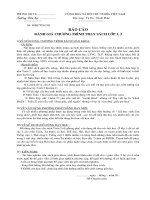Chết tế bào có chương trình
Bạn đang xem bản rút gọn của tài liệu. Xem và tải ngay bản đầy đủ của tài liệu tại đây (565.52 KB, 30 trang )
Chết tế bào có chương trình
TS.BS. Đồn Thị Kim Phượng
Chết tế bào do tổn thương
- Tổn thương cơ học
- Phơi nhiễm với chất độc hại
Chết tế bào tự nguyện
- Các tín hiệu nội sinh
- Các tín hiệu ngoại sinh
Chết tb có chương trình liên quan chặt chẽ tới
sự phân hủy protein, đứt gẫy ADN của tế bào.
Sau đó các sản phẩm này đc các tế bào khác
nhanh chóng thực bào.
Là một phần cần thiết trong cuộc sống của
mọi sinh vật đa bào
Đóng vai trị chính từ khi phát triển phôi cho
đến khi chết.
Apoptosis cần cho sự phát triển phôi thai
– Đứt đuôi nịng nọc
– Sự hình thành cấu tạo các ngón chân, ngón tay của thai nhi
Apoptosis cần để phá hủy tế bào
Examples:
– Tế bào bị nhiễm vius
– Tế bào của hệ thống miễn dịch
– Tế bào có ADN tổn thương
– Tế bào ung thư
Chết TB có chương trình vs.
Chết TB tổn thương
Chết TB tổn thương
•
•
•
•
TB sưng to
Vỡ màng
ATP bị suy yếu
TB ly giải, đáp ứng với
phản Ứng viêm
• DNA đứt gẫy ngẫu nhiên
hoặc nhịe
• Trong cơ thể, tồn bộ
vùng mơ bị ảnh hưởng
Chết Tb có chương trình
•
•
•
•
TB kết đặc
Màng cịn ngun vẹn
u cầu ATP
Tb bị thực bào, khơng có
phản ứng mơ
• DNA đứt gẫy từng vạch
• Trong cơ thể, các tb đơn
lẻ bị ảnh hưởng
NECROSIS Vs APOPTOSIS
Wilde, 1999
STAGES OF APOPTOSIS
Induction of apoptosis related genes, signal transduction
Sherman et al., 1997
APOPTOSIS: Morphology
organelle
membrane
blebbing &
changes
reduction
cell
mitochondrial
leakage
shrinkage
nuclear
fragmentation
chromatin
condensation
Hacker., 2000
APOPTOSIS: Morphological events
cell shrinkage
organelle reduction
mitochondrial leakage
chromatin condensation
nuclear fragmentation
membrane blebbing & changes
Blebbing & Apoptotic bodies
Bleb
The control retained over the cell
membrane & cytoskeleton allows intact
pieces of the cell to separate for
recognition & phagocytosis by MΦs
Apoptotic body
MΦ
MΦ
What makes a cell decide to commit suicide?
Withdrawal of positive signals
examples :
– growth factors for neurons
– Interleukin-2 (IL-2)
Receipt of negative signals
examples :
– increased levels of oxidants within the cell
– damage to DNA by oxidants
– death activators :
• Tumor necrosis factor alpha (TNF-α)
• Lymphotoxin (TNF-β)
• Fas ligand (FasL)
Caenorhabditis elegans
1090 cells
decision
to die
131 cells
execution
ced-3
ced-4
egl-1
ced-9
ces-2
ces-1
engulfment
ced-1
ced-2
ced-5
ced-6
ced-7
ced-10
apoptosis
degradation
nuc-1
Apoptosis: Pathways
“Extrinsic Pathway”
Death
Ligands
Death
Receptors
“Intrinsic Pathway”
DNA dama
ge &
p53
Mitochondria/
Cytochrome C
Initiator
Caspase 8
Effector
Caspase 3
Initiator
Caspase 9
PCD
MAJOR PLAYERS IN
APOPTOSIS
•
•
•
•
Caspases
Adaptor proteins
TNF & TNFR family
Bcl-2 family
Ligand-induced cell death
Ligand
Receptor
FasL
Fas (CD95)
TNF
TNF-R
TRAIL
DR4 (Trail-R)
Ligand-induced cell death
“The death receptors”
FasL
Ligand-induced trimerization
Trail
TNF
Death Domains
Death Effectors
Induced proximity
of Caspase 8
Activation of
Caspase 8
APOPTOSIS: Signaling & Control pathways I
Externally driven
Apoptotic signals
p53
Internally Cytochrome C
driven
mitochondrion
Externally driven
Activators of
initiator enzymes
Initiator caspases
6, 8, 9,12
Execution caspases
2, 3, 7
Apoptosis events
Activation
APOPTOSIS: Signaling & Control pathways II
Externally driven
Apoptotic signals
p53
Internally Cytochrome C
Bcl2
driven
Externally driven
Inhibitors
Activators of
initiator enzymes
Initiator caspases
6, 8, 9,12
External Survival
Internal factors
Execution caspases
2, 3, 7
Apoptosis events
Inhibitors of
apoptosis
Inhibition
The mitochondrial pathway
DNA
Fas
damage
Casp8
p53
Growth factor
receptors
PI3K
Bid
Bid
Bax
Bid
Bax
Akt
casp3
BAD
Bcl2
casp9
Apaf1ATP
Cyt.C
IAPs
casp3
Smac/
DIABLO
H2O2
AIF
Pollack etal., 2001
REGULATION OF APOPTOSIS
Stimuli→ apoptosis →selection of targets
et al., 2000)
Apoptosis by conflicting signals that scramble the
normal status of cell
(Canlon & Raff, 1999)
Apoptotic stimuli→cytokines, death factors (FasL)
(Tabibzadeh et al., 1999)
DNA breaks → p53 is activated →arrest cell cycle or
activate self destruction
(Blaint & Vousden, 2001)
(Rich
Importance of Apoptosis
• Important in normal physiology / development
– Development: Immune systems maturation,
Morphogenesis, Neural development
– Adult: Immune privilege, DNA Damage and wound
repair.
• Excess apoptosis
– Neurodegenerative diseases
• Deficient apoptosis
– Cancer
– Autoimmunity
FUTURE PERSPECTIVES
The biological roles of newly identified death
receptors and ligands need to be studied
Need to know whether defects in these ligands
and receptors contribute to disease
CONCLUSION
an important process of cell death
can be initiated extrinsically through death ligands
(e.g. TRAIL, FasL) activating initiator caspase 8 through
induced proximity.
can be initiated intrinsically through DNA damage (via
cytochrome c) activating initiator caspase 9 through
oligomerization.
Initiator caspases 8 and 9 cleave and activate
effector caspase 3, which leads to cell death.









